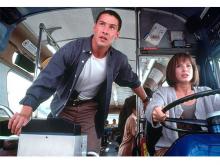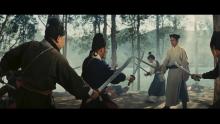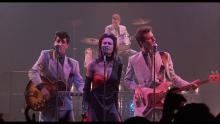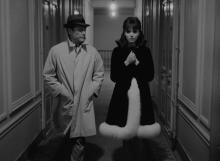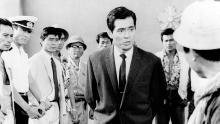The following notes on The Small Back Room were written by Josh Martin, PhD student in the Department of Communication Arts at UW Madison. A newly restored 4K DCP of The Small Back Room will screen on Friday, July 5, 7 p.m., in the Cinematheque's regular venue 4070 Vilas Hall, 821 University Ave. Admission is Free.
By Josh Martin
In the London war offices depicted in Michael Powell and Emeric Pressburger’s The Small Black Room (1949), an assortment of background signs provide a grim insistence on nightly wartime rules: “Don’t forget the blackout!” Set in 1943 at the height of the Second World War, the anxious, gloomy atmosphere engendered by the mandated preventative blackout enhances the viewer’s experience of this cinematic nocturne. As the preeminent mid-century British filmmakers, Powell and Pressburger (known collectively as The Archers) are still best known today for their elaborate use of Technicolor. Whether in service of the lavish, fantastical ballet of The Red Shoes (1948), the feverish desires of Black Narcissus (1947), or even the floral gardens of A Matter of Life and Death (1944), the legacy of the Archers is inseparable from their probing of cinematic color’s emotional and affective possibilities. However, the Archers were no strangers to the affordances of black-and-white, demonstrated by collaborations such as I Know Where I’m Going (1945) and The Small Back Room, a film that draws on moody shadows and expressionistic style to craft a tale of British despondence, resilience, and redemption.
Based on a 1943 novel by Nigel Balchin, Powell and Pressburger’s film introduces viewers to a cramped, chaotic space in the London offices of the British army, where a compendium of misfit scientists experiment with the latest in weapons technology to serve in the fight against the Germans. Operating like a disorganized, miniature Los Alamos, the “back room boys” attempt to marry their knowledge of statistics with the “feel” of weaponry as experienced by the everyday soldiers. Sammy Rice (played by David Farrar, a favorite of the Archers) is a specialist in munitions and bombs working out of this back room, but he is struggling with a disability: the loss of his foot in action. Left in endless, excruciating pain, Sammy alternates between popping pills and failing to stay away from any whiskey he can get his hands on, doing whatever it takes to mitigate the misery of his prosthetic foot. Despite the support of his love interest, war office assistant Susan (Kathleen Byron, another member of the Archers’ stock company), Sammy spends most of his time stuck in a cycle of discontent and snarky self-loathing, cynically lamenting his lot. However, Sammy finds a chance at a purpose when approached by Captain Dick Stuart (Michael Gough), who informs him of the existence of a dangerous new German bomb that the military has thus far struggled to successfully disable.
The Small Back Room arrived at a transition point in the career of the Archers. As described by Powell in his autobiography, A Life in Movies, a rift had formed between the filmmakers and J. Arthur Rank. The superproducer, who shepherded many of the Archers’ most notable triumphs of the 1940s, was profoundly unhappy with the prospects of The Red Shoes. As the Archers grew more frustrated with Rank and his lack of confidence, the independent filmmakers were also being wooed by Alexander Korda, the head of British Lion Productions. Powell approached Korda with the idea of adapting The Small Back Room, which, from his vantage point, “had a great suspense sequence” at its climax and an “ideal” role for Black Narcissus star Farrar. Korda, unfamiliar with the book, agreed to buy the rights if Powell and Pressburger were interested in adapting it for the screen. Rank ultimately decided, along with his associate John Davis, to dump The Red Shoes into theaters with little fanfare and no premiere. This decision sparked, in Powell’s words, the conclusion of “one of the greatest partnerships in the history of British films.” The Archers agreed to a five picture deal with Korda, the first of which would be The Small Back Room.
Powell and Pressburger were familiar with dramatizing British perspectives on World War II. The catastrophic conflict – and the decades leading up to it, as presented in 1943’s epic The Life and Death of Colonel Blimp – had been a central subject for the directors throughout the 1940s. Far from a retread, The Small Back Room offers a distinct approach that expands on the Archers’ previous explorations of World War II-era Britain, placing an emphasis on the London home front – on the bureaucratic politics and behind-the-scenes machinations that shaped the war effort. This national portrait works in careful conjunction with the film’s more penetrating character study of Sammy Rice, whose endurance and recovery from his shattering, alcoholic despair mirrors Britain’s own comeback and ultimate victory in the war.
Though triumph is on the horizon by the film’s end, our subject matter is stark – and starkly reflected by the non-naturalistic shadows and sinister ambience of the film’s black-and-white world. Powell admitted to incorporating his love of the great German expressionist films into The Small Back Room, and we see the fruits of this influence in the surfeit of canted angles, in the cavernous, twisted spaces inside the war office – all united by the low visibility and limited illumination provided by cinematographer Chris Challis’ black-and-white compositions. Most prominently, such influence is visible in the noteworthy sequence criticized upon release by Britain’s Monthly Film Bulletin as a “lapse… into surrealistic camerawork.” One must forgive the Bulletin for its own “lapse” of judgment, as the scene in question is one of the most astonishing in the Archers’ filmography.
Resembling the Salvador Dalí-designed interlude in Hitchcock’s Spellbound (1945) or, perhaps more aptly, the drunken dreams of grandeur by Emil Jannings’ lowly porter in F.W. Murnau’s The Last Laugh (1924), Powell and Pressburger present an assortment of nightmarish sounds and images that represent the inner turmoil of Sammy, now at his lowest point in the film. As a clock ticks loudly in the soundscape, the camera lingers on Sammy’s gaze, fixated on a whiskey bottle. The clock grows louder, with the film alternating between images of the clock’s inner workings and striking close-ups of a pained look on Sammy’s face. Eventually, the scene itself morphs into an abstract and distorted space, inundating Sammy and the spectator with strange visual reminders of his addictions, failings, and overwhelming fears. The whiskey bottle grows larger, the alarm clock becomes louder, and our tortured protagonist finds himself one step closer to his breaking point.
This commitment to formal innovation is evident throughout The Small Back Room, from the exchange of intimate close-ups on Farrar and Byron’s expressive faces to the meticulous tension of the climactic bomb disposal, a quiet exercise in stillness and unease. Down on his luck and in dire pain, facing a high likelihood of death, Sammy still approaches the bomb hoping for some insight that could help beat the Germans. “Are you sure you can manage?” the captain asks. With a typically British stiff upper lip, Sammy can only chuckle and smile, responding: “Suppose I’ll have to.” In a resurgent moment for the Archers in contemporary film culture, highlighted by the North American tour of the British Film Institute’s “Cinema Unbound” retrospective and the forthcoming release of the Martin Scorsese-produced Powell/Pressburger documentary Made in England, The Small Back Room is a prime candidate for rediscovery and further appreciation. Among their many canonized classics, the film remains a key chapter in their oeuvre, a visually accomplished character study that doubles as an essential work of postwar British self-mythologizing.


